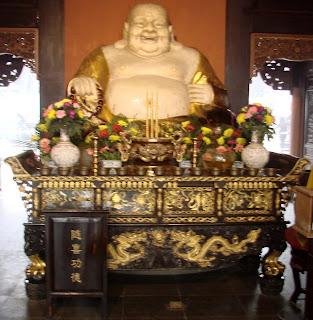One of the most remarkable days. Not because of the views, since one could hardly see anything, but because of the experience... We went by bus to some place on Mount Emei, from which we started hiking to the top. Emei Shan (Mount Emei) is one of the Four Sacred Buddhist Mountains of China, and - with its 3099 m - the highest of them. In 1996 it became a UNESCO World Heritage Site (together with the Leshan Giant Buddha). It is known as the place of Buddha's son - Puxian (Samantabhadra) - enlightment, and that's why one can find a beautiful golden statue of him at the summit. So, as many pilgrims, we decided to hike the mountain to enjoy the view. Though, the weather was not the best for such a trip. First of all, stairs and paths were covered with an ice layer below some snow. Additionally, we walked all the way in a drizzle and fog...
Jeden ze szczególnych dni. Nie ze względu na widoki, jako że niewiele można było zobaczyć, ale z powodu doświadczeń... Dojechałyśmy busem do pewnego miejsca na Emei Shan, skąd rozpoczęłyśmy wspinaczkę na szczyt. Emei Shan jest jedną z czterech świętych gór buddyzmu i wznosząc się na wysokość 3099 m - najwyższą z nich. W 1996 roku została wpisana na listę światowego dziedzictwa UNESCO (razem z rzeźbą Wielkiego Buddy z Leshan). Jest znana jako miejsce oświecenia syna Buddy - Puxiana (Samantabhadry), dlatego na szczycie można znaleźć przedstawiający go piękny złoty pomnik. Jak wielu pielgrzymów, postanowiłyśmy więc wspiąć się na górę, żeby podziwiać ten widok. Jednakże, pogoda nie była najlepsza na taką wycieczkę. Po pierwsze, schody i ścieżki pokryte były warstwą lodu przykrytą śniegiem. Ponadto, całą drogę szłyśmy w mżawce i mgle...


The last part before the top - stairs with beautiful elephant (with 6 tusks) statues on both sides. Perhaps, when visible, one could feast one's eyes upon them and indulge in a great view. Well, we at least saw contours of some of them.
Ostatnia część przed szczytem - schody z pięknymi pomnikami słoni (z 6 kłami) po dwóch stronach. Zapewne, kiedy widoczne, zapewniają ucztę dla oczu i pozwalają cieszyć się wspaniałym widokiem. Cóż, przynajmniej widziałyśmy kontury niektórych z nich.

The track was supposed to take around 2 hours, but it took more than 3. After struggling in the drizzle on the icy roads, we finally made it. The summit! Again, lots of elephants - this time around the great golden statue...
Droga powinna zająć około 2 godzin, jednak zajęła więcej niż 3. Po utarczkach w mżawce na oblodzonych drogach, w końcu się udało. Szczyt! Ponownie dużo słoni - tym razem naokoło wielkiego złotego pomnika...

And the statue itself. We believe it was somewhere there in a cloud...
I sam pomnik. Wierzymy, że był gdzieś tam w chmurze...

At least we could see something inside temples, where we planned to sleep.
Przynajmniej mogłyśmy cokolwiek zobaczyć wewnątrz świątyń, gdzie zamierzałyśmy przenocować.


Before coming there, we asked in Emei if it's possible to stay overnight somewhere at the top and we were informed that temples offer such an opportunity. Well, they do. But apparently only during summer months. So, the last bus going down leaves in 1,5 h from the place where we arrived. We have an icy road in front of us. Plus we are soaked and pretty tired. And the visibility is... just impressive. The distance between U and M (taking the photo) in this picture is ~20 steps.
Przed przyjazdem, pytałyśmy w Emei czy można zatrzymać się na noc na szczycie i zostałyśmy poinformowane, że świątynie oferują taką możliwość. Oferują. Ale widocznie tylko w czasie miesięcy letnich. Tak więc, jesteśmy na górze, a ostatni bus na dół odjeżdża za półtorej godziny z miejsca, do którego przyjechałyśmy. Mamy przed sobą oblodzoną drogę. Do tego jesteśmy przemoczone i zmęczone. A widoczność... po prostu robi wrażenie. Na zdjęciu poniżej odległość między U i M (robiącą zdjęcie) wynosi ok. 20 schodków.

Luckily, there is a cable car on our way. Unfortunately, the box office is closed. We need to wait. There's 45 minutes left. They finally open the box office and we get the tickets. Of course there's a huge queue to the car. Well, let's play it rough - the Asian style. Jumping over fences, some running, and pretending we don't understand Chinese - a few minutes later we're in a car, going down. There's still quite a distance to make - stairs or road. We choose road. Taking shortcuts by almost sliding down the slope and using trees to brake. Finally, we arrive to the parking, find our bus and get in. Two minutes later it leaves. We made it! :)
Na szczęście, na naszej drodze jest kolejka linowa. Niestety, kasa jest zamknięta. Musimy poczekać. Zostało 45 minut. W końcu otwierają kasę i dostajemy bilety. Oczywiście do wagonów jest ogromna kolejka. Cóż, zagrajmy ostro - po azjatycku. Skakanie przez płotki, trochę biegania i udawanie, że nie rozumiemy po chińsku - kilka minut później jesteśmy w wagoniku, jadąc na dół. Wciąż zostaje pewna odległość do zrobienia - schody albo jezdnia. Wybieramy jezdnię. Skracamy drogę przez praktycznie ześlizgiwanie się po zboczu i używanie drzew do hamowania. W końcu, docieramy na parking, znajdujemy nasz bus i wsiadamy. Dwie minuty później odjeżdżamy. Udało się! :)















































